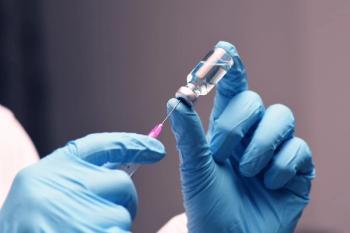
Residual Effect of Refractive Surgery
During a basketball game, a 23-year-old soldier had been hit in the right eye with the ball. The eye was slightly red with copious lacrimation; vision was normal. Using a Wood lamp and fluorescein dye, MAJ Kenneth S. Brooks, APA-C, of Camp As Sayliyah, Doha, Qatar, examined the patient's eye for corneal abrasions and saw these results. Note the almost complete halo of dye, with gaps at the 6 o'clock and 11 o'clock positions on the iris. This curious phenomenon was baffling until the soldier was asked about recent eye surgeries; he answered that he had undergone photorefractive keratectomy (PRK) several months earlier.
During a basketball game, a 23-year-old soldier had been hit in the right eye with the ball. The eye was slightly red with copious lacrimation; vision was normal. Using a Wood lamp and fluorescein dye, MAJ Kenneth S. Brooks, APA-C, of Camp As Sayliyah, Doha, Qatar, examined the patient's eye for corneal abrasions and saw these results. Note the almost complete halo of dye, with gaps at the 6 o'clock and 11 o'clock positions on the iris. This curious phenomenon was baffling until the soldier was asked about recent eye surgeries; he answered that he had undergone photorefractive keratectomy (PRK) several months earlier.
PRK was developed before laser in situ keratomileusis (LASIK). In LASIK, the surgeon creates a flap on the cornea using a microkeratome, reconfigures the cornea with the laser, and then reapproximates the flap. In PRK, the surgeon scrapes away the corneal epithelium, then directs the laser on the exposed cornea. The surgeon places protective contact lenses over the surgical sites on both eyes, and the corneal epithelium regenerates within a few days.
Patients who undergo PRK recover slightly more slowly than those who undergo LASIK, and they experience greater discomfort. However, the resulting visual acuity is comparable with both surgeries. With PRK, the absence of a flap eliminates the risk of the flap detaching when exposed to extreme forces (such as high-speed winds during parachute operations).
Fortunately, the uptake of fluorescein dye revealed no trauma, only the revised corneal shaping from PRK. Nevertheless, the patient's eye was irrigated with Ringer lactate, and he was given an antibiotic ophthalmic ointment to apply twice daily for 3 days to prevent infection.
Newsletter
Enhance your clinical practice with the Patient Care newsletter, offering the latest evidence-based guidelines, diagnostic insights, and treatment strategies for primary care physicians.



























































































































































































































































































